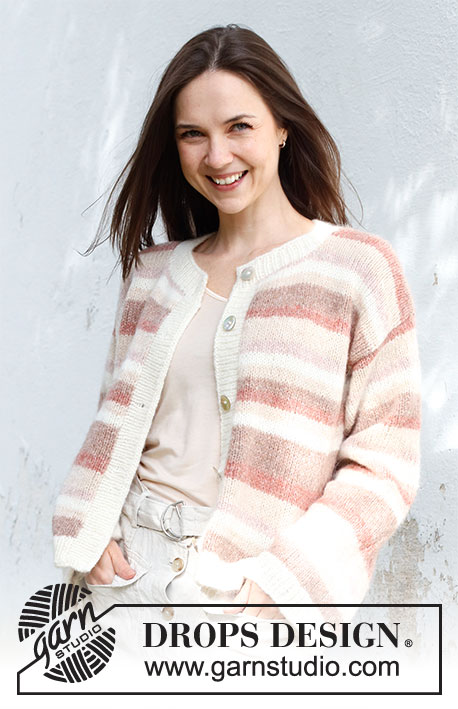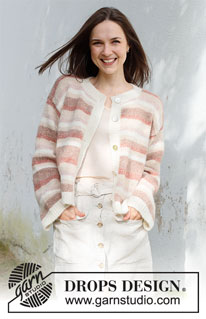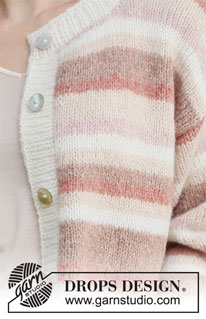Mars Sunrise |
||||
 |
 |
|||
Knitted jacket in DROPS Air. The piece is worked bottom up with stripes. Sizes S - XXXL.
DROPS 232-22 |
||||
|
------------------------------------------------------- EXPLANATIONS FOR THE PATTERN: ------------------------------------------------------- RIDGE/GARTER STITCH (worked back and forth): Knit all rows. 1 ridge = knit 2 rows. STRIPES: * 8 rows with color pink marble, 4 rows with color wheat, 4 rows with color off-white, 4 rows with color pink sand, 8 rows with color wheat, 6 rows with color blush, 12 rows with color pink marble, 4 rows with color off-white, 4 rows with color wheat, 4 rows with color blush, 4 rows with color pink marble, 4 rows with color wheat, 4 rows with color off-white, 4 rows with color pink sand, 8 rows with color wheat, 4 rows with color blush *, repeat from *-*. INCREASE TIP (under sleeves): Work until there are 2 stitches left before the marker, 1 yarn over, knit 4 (marker thread sits between these 4 stitches), 1 yarn over. On the next round knit the yarn overs twisted to avoid holes. Then work the new stitches in stockinette stitch. ------------------------------------------------------- START THE PIECE HERE: ------------------------------------------------------- JACKET - SHORT OVERVIEW OF THE PIECE: The back and front pieces are worked separately, with circular needle, back and forth and bottom up. The bands are worked on the front pieces. The sleeves are worked in the round with double pointed needles/short circular needle. The piece is sewn together and the neck is worked to finish. BACK PIECE: Cast on 105-113-123-133-145-161 stitches with circular needle size 4 MM = US 6 and DROPS Air in color off-white. Purl 1 row from the wrong side. Then work rib from the right side as follows: 1 edge stitch in GARTER STITCH – read description above, * knit 1, purl 1 *, work from *-* until there are 2 stitches left, knit 1 and 1 edge stitch in garter stitch. When the rib measures 4 cm = 1½", change to circular needle size 5 MM = US 8. Continue with stockinette stitch, 1 edge stitch in garter stitch on each side and STRIPES – read description above; AT THE SAME TIME, on row 1 decrease 17-19-21-23-25-27 stitches evenly spaced = 88-94-102-110-120-134 stitches. REMEMBER THE KNITTING GAUGE! When the piece measures 33-34-35-36-37-38 cm = 13"-13⅜"-13¾"-14¼"-14½"-15", bind off 6-7-9-10-12-17 stitches at the beginning of the next 2 rows for the armholes = 76-80-84-90-96-100 stitches. When the piece measures 50-52-54-56-58-60 cm = 19¾"-20½"-21¼"-22"-22¾"-23⅝", bind off the middle 26-28-30-32-34-36 stitches for the neck and finish each shoulder separately. Bind off 1 stitch on the next row from the neck = 24-25-26-28-30-31 stitches on the shoulder. Bind off when the piece measures 52-54-56-58-60-62 cm = 20½"-21¼"-22"-22¾"-23⅝"-24⅜". Work the other shoulder in the same way. LEFT FRONT PIECE: Cast on 54-58-62-68-74-82 stitches with circular needle size 4 MM = US 6 and DROPS Air in color off-white. Purl 1 row from the wrong side. Then work rib from the right side as follows: 1 edge stitch in garter stitch, * purl 1, knit 1 *, work from *-* until there is 1 stitch left, 1 edge stitch in garter stitch. When the rib measures 4 cm = 1½", change to circular needle size 5 MM = US 8. Continue with stockinette stitch, 1 edge stitch in garter stitch on each side and stripes; AT THE SAME TIME, on row 1 decrease 9-10-10-12-13-14 stitches evenly spaced = 45-48-52-56-61-68 stitches. When the piece measures 33-34-35-36-37-38 cm = 13"-13⅜"-13¾"-14¼"-14½"-15", bind off the first 6-7-9-10-12-17 stitches on the next row from the right side for the armhole = 39-41-43-46-49-51 stitches. When the piece measures 46-48-49-51-52-54 cm = 18"-19"-19¼"-20"-20½"-21¼", place the first 11-12-13-14-15-16 stitches on the next row from the wrong side on a thread for the neck (working them first), then bind off at the beginning of each row from the wrong side: 2 stitches 1 time, then 1 stitch 2 times = 24-25-26-28-30-31 stitches on the shoulder. Bind off when the piece measures 52-54-56-58-60-62 cm = 20½"-21¼"-22"-22¾"-23⅝"-24⅜". LEFT BAND: Knit up from the right side 94 to 110 stitches with color off-white and circular needle size 4 MM = US 6, inside the 1 edge stitch and down the left front piece (number of stitches should be divisible by 2). Work as follows from the bottom and wrong side: 2 edge stitches in garter stitch, * purl 1, knit 1 *, work from *-* until there are 2 stitches left, purl 1 and 1 edge stitch in garter stitch. Continue this rib back and forth for 4 cm = 1½" (adjust so the next row is from the wrong side). Knit 1 row from the wrong side and bind off with knit from the right side. RIGHT FRONT PIECE: Cast on 54-58-62-68-74-82 stitches with circular needle size 4 MM = US 6 and DROPS Air in color off-white. Knit 1 row from the wrong side. Then work rib from the right side as follows: 1 edge stitch in garter stitch, * knit 1, purl 1 *, work from *-* until there is 1 stitch left, 1 edge stitch in garter stitch. When the rib measures 4 cm = 1½", change to circular needle size 5 MM = US 8. Continue with stockinette stitch, 1 edge stitch in garter stitch on each side and stripes; AT THE SAME TIME, on row 1 decrease 9-10-10-12-13-14 stitches evenly spaced = 45-48-52-56-61-68 stitches. When the piece measures 33-34-35-36-37-38 cm = 13"-13⅜"-13¾"-14¼"-14½"-15", bind off the first 6-7-9-10-12-17 stitches on the next row from the wrong side for the armhole = 39-41-43-46-49-51 stitches. When the piece measures 46-48-49-51-52-54 cm = 18"-19"-19¼"-20"-20½"-21¼", place the first 11-12-13-14-15-16 stitches on the next row from the right side on a thread for the neck (working them first), then bind off at the beginning of each row from the right side: 2 stitches 1 time, then 1 stitch 2 times = 24-25-26-28-30-31 stitches on the shoulder. Bind off when the piece measures 52-54-56-58-60-62 cm = 20½"-21¼"-22"-22¾"-23⅝"-24⅜". RIGHT BAND: Knit up from the right side 94 to 110 stitches with color off-white and circular needle size 4 MM = US 6, inside the 1 edge stitch and up the right front piece (number of stitches should be divisible by 2). Work as follows from the top and wrong side: 1 edge stitch in garter stitch, * purl 1, knit 1 *, work from *-* until there are 3 stitches left, purl 1 and 2 edge stitches in garter stitch. Continue this rib back and forth for 2 cm = ¾". Now work 4-4-4-5-5-5 buttonholes evenly along the band. The bottom buttonhole is positioned 6 cm = 2⅜" up from the bottom edge and the top buttonhole 7-8 cm = 2¾"-3⅛" down from the top edge (the last buttonhole is worked when you work the neck). Work the buttonholes by making 1 yarn over and working 2 together. Continue the rib for another 2 cm = ¾". Knit 1 row from the wrong side and bind off with knit from the right side. SLEEVES: Cast on 62-64-66-68-70-72 stitches with double pointed needles size 4 MM = US 6 and color off-white. Knit 1 round then work rib in the round (knit 1, purl 1) for 4 cm = 1½". Change to double pointed needles size 5 MM = US 8. Knit 1 round where you decrease 6 stitches evenly spaced = 56-58-60-62-64-66 stitches. Insert 1 marker at the beginning of the round = mid-under sleeve. Continue with stockinette stitch and stripes. When the sleeve measures 8 cm = 3⅛", increase 1 stitch on each side of the marker – read INCREASE TIP. Increase like this every 12-9-7-6½-5-4 cm = 4¾"-3½"-2¾"-2½"-2"-1½" a total of 4-5-6-6-7-8 times = 64-68-72-74-78-82 stitches. When the sleeve measures 47-47-46-44-42-39 cm = 18½"-18½"-18"-17¼"-16½"-15¼", work the sleeve cap back and forth from mid-under the sleeve for 4-4-5-6-7-10 cm = 1½"-1½"-2"-2⅜"-2¾"-4". Bind off. Work the other sleeve in the same way. ASSEMBLY: Sew the shoulder seams. Sew the sleeve cap to the armhole, then the split to the bottom of the armhole – see sketch. Sew the side seams inside the 1 edge stitch. NECK: Start from the right side and knit up 81 to 123 stitches around the neck with circular needle size 4 MM = US 6 and color off-white (including the bands and the stitches on the threads), The number of stitches should be divisible by 2 + 1. Work as follows from the wrong side: 1 edge stitch in garter stitch, purl 1, * knit 1, purl 1 *, work from *-* until there are 1 stitch left, 1 edge stitch in garter stitch. Continue this rib for 2 cm = ¾". Now work the last buttonhole at the beginning of the next row from the right side: 1 edge stitch in garter stitch, knit 1, purl 1, knit 2 together, 1 yarn over, then work to the end of the row. Continue the rib for a further 2 cm = ¾". Loosely bind off with knit from the right side. ASSEMBLY-2: Sew the buttons onto the left band. |
||||
Diagram explanations |
||||
|
||||

|
||||

|
||||
|
Have you made this or any other of our designs? Tag your pictures in social media with #dropsdesign so we can see them! Do you need help with this pattern?You'll find tutorial videos, a Comments/Questions area and more by visiting the pattern on garnstudio.com. © 1982-2024 DROPS Design A/S. We reserve all rights. This document, including all its sub-sections, has copyrights. Read more about what you can do with our patterns at the bottom of each pattern on our site. |
||||



































































Comments / Questions (9)
IL y a une erreur dans le nombre de pelotes: j'ai eu besoin de 2,5 pelotes du coloris 34, c'était très gênant car j'ai été bloqué dans mon tricot, le temps de recevoir ma pelote supplémentaire.
22.02.2024 - 16:52DROPS Design answered:
Bonjour Mara, tricotez-vous bien en DROPS Air? Quelle taille tricotez-vous? Avez-vous bien la bonne tension en hauteur en tricotant? Autrement dit toujours 22 rangs = 10 cm? Merci pour votre retour. Bonne continuation!
23.02.2024 - 08:28Hej:) Jeg vil blot lige høre, om det er korrekt, at man skal bruge næsten samme garnmængde til alle størrelser, eller er det en fejl?
19.07.2023 - 08:49DROPS Design answered:
Hei Margrethe. Det skiller 100 gram / 300 meter fra den minste til den største str. Nå har jeg ikke oversikten over garnutregningen, men det kan godt hende at i f.eks i str. M i farge 01 natur så går det 104 gram, mens i str XXXL går det 148 gram. Da må begge ha 150 gram 01, natur. Man vil kanskje ha mer garn igjen i de minste str. der det er den samme garnmengden som i de største str., men man kan ikke skrive f.eks 50 gram om det er brukt f.eks 53 gram. mvh DROPS Design
25.07.2023 - 08:53Hva menes det med "Fell av masker 1 gang og deretter 1 maske 2 ganger =[...]" på venstre og høyre forstykke?
20.04.2023 - 13:39DROPS Design answered:
Hei Gunhild. Her var et tall (2) blitt borte under VENSTRE FORSTYKKE. Var riktig under høyre forstykke. Takk for at du gjorde oss oppmerksom på dette. Vi vil fikse dette asap. mvh DROPS Design
24.04.2023 - 11:48My granddaughter likes your Candy Bar Jacket pattern but she is 142cm and growing. Do you have a similar pattern with balloon sleeves which I could use. I like this Mars Sunrise (for women) but can't work out your sizing. I have some wool that is 17 st and 28 rows for 10 sq cm that I would like to use. Many thanks for your help
08.04.2023 - 16:53DROPS Design answered:
Dear Judy, the measurements for each size are indicated in the schematic after the pattern instructions; to better understand them you can read the following lesson: https://www.garnstudio.com/lesson.php?id=24&cid=19. Some patterns similar to Candy Bar Jacket could be these: https://www.garnstudio.com/pattern.php?id=9009&cid=19 https://www.garnstudio.com/pattern.php?id=9393&cid=19. You should be able to use the same yarn for these patterns as in the Candy Bar Jacket. Happy knitting!
08.04.2023 - 22:46Is het mogelijk om de het vest met gewone naalden ipv rondbreinaalden te breien .
28.03.2023 - 11:11DROPS Design answered:
Dag Ruth,
Ja, je zou dit vest ook wel met gewone naalden kunnen breien. Om een patroon aan te passen om op rechte naalden te breien hebben we een instructie gemaakt. Deze vind je hier.
28.03.2023 - 21:18Hvorfor skal der strikket med pind 5 på på højre forkant og pind 4 på Venstre forkant . Er det en fejl
24.03.2023 - 08:40DROPS Design answered:
Hei Connie. Ja,her er det feil. Høyre og venstre stolpe skal strikkes med samme pinne, pinne 4, samme som vrangborden. Takk for at du gjorde oss oppmerksom på dette, vi skal få ordnet dette asap. mvh DROPS Design
27.03.2023 - 13:23Bonjour pour la taille M : après avoir tricoter pour la manche 46 cm vous dites \"tricotez la tête de manche sur 5 cm\". Cela veut -il seulement dire de continuer à tricoter.sans diminution ..?\r\nA quoi correspondent les pointillés sur le graphique?\r\nMerci de votre réponse
16.01.2023 - 13:31DROPS Design answered:
Bonjour Mme Siksou, tout à fait, à 47 (pas 46, la taille M est la 2ème taille) cm de hauteur totale, on tricote désormais en rangs, à partir du milieu sous la manche, mais sans rabattre ni diminuer. Les lignes pointillés correspondent aux parties b et B: b = les 4 cm tricotés en rangs à la fin de la manche, B = les mailles rabattues pour les emmanchures. Cette vidéo montre comment on va assembler la manche. Bon tricot!
16.01.2023 - 16:31Hej! När det står "Garngrupp C eller A + A", betyder det att jag kan använda samma mönster, men ta 2 trådar av ett garn som är inom garngrupp A? Så jag använder samma storlek på stickor mm, men bara tar 2 trådar istället?
08.11.2022 - 09:34DROPS Design answered:
Hej Eva, ja det stemmer, men husk at strikke en prøve, så strikkefastheden bliver samme som i det mønster du følger :)
08.11.2022 - 14:21Schöne Farben. Sugar Ray klingt gut
08.02.2022 - 19:42